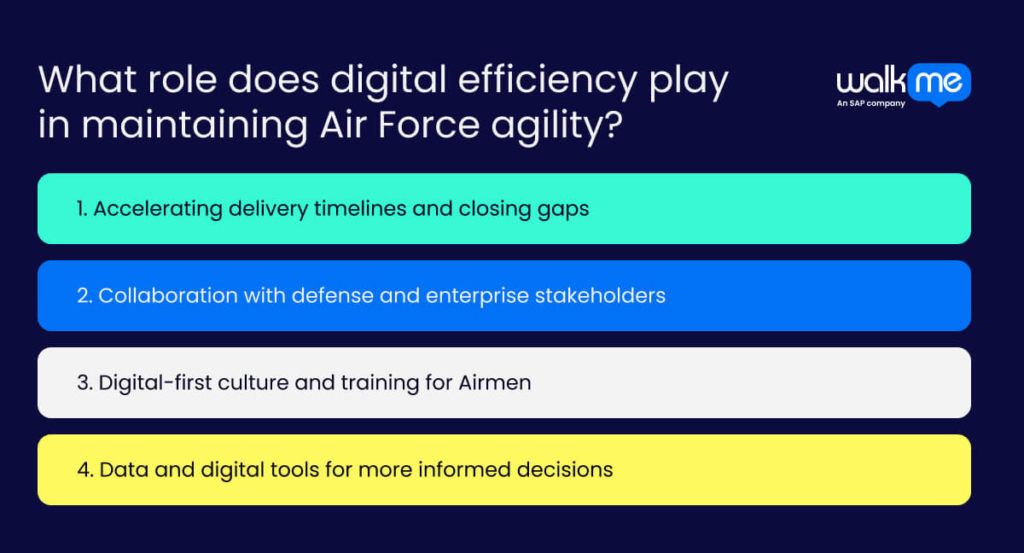Across hangars, command centers, and flight lines, the U.S. Air Force is wrestling with a growing challenge of turning vast amounts of data into decisive action.
A recent deployment of predictive analytics on C‑5 Galaxy transports reduced unscheduled maintenance by 30%, while boosting aircraft availability by 20%—clear proof that digital efficiency drives resilience.
Real-time monitoring and AI are also making an impact on military digital efficiency, enabling the Air Force to transform guesswork into predictive certainty.
If the future depends on speed and reliability, digital efficiency is what lets the Air Force keep its aircraft ready, its operations smooth, and its people poised to respond.
This article will examine how digital efficiency enables the Air Force to maintain its operations as mission-ready, adaptable, and poised to respond to whatever comes next.
What is digital efficiency in the U.S. Air Force?
Digital efficiency in the US Air Force means optimizing operations by converting raw data into actionable insights that reduce downtime, cut costs, and enhance readiness.
It centralizes maintenance, logistics, and supply chain information, applying AI and workforce analytics to automate decisions.
For example, the Rapid Sustainment Office’s PANDA toolkit analyzes large amounts of maintenance and logistics data across 16 aircraft platforms. It generates over 30,000 asset performance management (APM) alerts monthly, helping avert equipment failures and streamline downtime.
Shifting from reactive repair to proactive upkeep, digital efficiency yields some very measurable gains. These include less unplanned maintenance, smarter inventory, and more mission-capable aircraft.
Why is digital efficiency in the U.S. Air Force important?
Digital efficiency is important for the US Air Force for several reasons.
Aircraft, maintenance teams, and command centers must react quickly and adapt to change, responding to shifting situations.
Digital tools speed up repairs, improve supply chain management, and give clear, real-time updates on readiness. This lets the Air Force focus more on employee training, maintenance, and innovation.
A notable example is the Air Force’s Digital Twin program, which creates virtual models of aircraft components. This helps crews identify issues, test fixes, and plan maintenance without taking the plane apart. It also reduces wear and extends the life of important equipment.
Newly implemented digital systems combine data from numerous sources, giving leaders a full view to make better decisions about budgets, spare parts, and technical support.
These digital efficiency improvements help the Air Force stay flexible, efficient, and mission-ready.
What is the role of digital material management in digital efficiency?
Digital material management is a relatively new development and, when used by the US military, applies digital technologies and tools to track and oversee the entire lifecycle of materials.
It ensures that the right parts and supplies are available when and where they are needed, which helps keep equipment functional and missions on track. In the past, the U.S. Air Force relied on manual tracking and paper records, which often led to delays. Digital material management replaces this with automated systems that track items in real time.
In 2023, the Department of Defense disclosed that 61% of its $3.5 trillion in assets could not be properly accounted for. This highlights ongoing challenges with visibility and oversight, making it harder for military planners to track equipment, minimize waste, and make the best use of resources.
Digital material management helps address these gaps by strengthening oversight, improving accuracy, and ensuring the military is prepared to respond at the flip of a switch. It also links parts data with maintenance schedules, so components arrive just in time. This stops emergency orders and reduces downtime.
As a key part of the military’s efficiency mandate, digital material management uses digital tools to encourage better decisions through enhanced operations.
What are the core pillars of digital efficiency in the U.S. Air Force?

By now, you should have a clear understanding of what digital efficiency means for the US Air Force, why it matters, and how digital material management helps make it a reality.
The following section covers the core pillars of digital efficiency. Understanding these pillars is crucial for transforming organizational complexity into clear strategies that drive sustained performance within the U.S. Air Force.
Let’s take a closer look at the core pillars of digital efficiency in the U.S. Air Force:
Modernizing IT infrastructure
Updating the Air Force’s IT systems is key to improving digital efficiency. Replacing old equipment and slow networks with faster, cloud ecosystems helps data move quickly and supports new tools like AI.
This reduces downtime, improves security, and helps different systems work in tandem. With a modern tech stack, the Air Force can respond more quickly and effectively to new challenges. Without these upgrades, digital tools won’t perform as well or deliver their full benefits.
Industry consortia
The Air Force partners with groups of companies and universities, called industry consortia, to speed up innovation and save money. These partnerships allow for the sharing of ideas and resources to develop new technology.
Using proven commercial tools helps the Air Force advance while keeping systems secure. Industry consortia connect military needs with the latest technology, enabling the Air Force to stay ahead in a rapidly changing world.
Digital materiel management industry association consortium (IAC)
The Digital Material Management Industry Association Consortium (IAC) brings together the Air Force and industry experts to improve the management of supplies and parts. Working as a team, they share new ideas, tools, and best methods to speed up fixing problems and cut costs.
The IAC helps make sure important equipment is ready when needed, improving readiness and keeping the Air Force strong and efficient. This partnership also turns complex supply challenges into smart, practical solutions.
Secure and structured data
Having data that is both well-organized and protected is essential for the Air Force’s digital efficiency. A refined data strategy enables teams to analyze information quickly and accurately, facilitating informed planning of maintenance, resources, and decisions.
Strong security safeguards sensitive data from threats, thereby protecting missions. Without safe and organized data, digital systems may fail or produce incorrect results.
What role does digital efficiency play in maintaining Air Force agility?

Now that you have a deeper understanding of the core pillars of digital efficiency in the US Air Force, it’s time to explore how digital efficiency supports agility.
Agility is a critical focus today, enabling the Air Force to adapt quickly to changing threats and mission demands. Digital efficiency provides the tools and insights needed to make fast, informed decisions, keeping the force responsive and ready for whatever challenges lie ahead.
Let’s take a closer look at how the U.S. Air Force uses digital efficiency to maintain agility:
Accelerating delivery timelines and closing gaps
Digital tools help the Air Force deploy new technology and fixes to the field more quickly. Process automation of routine tasks frees up time and resources for critical duties. This means equipment and software arrive sooner, reducing delays that could hurt missions. Moving quickly without cutting corners lets the Air Force adjust to changing needs. Faster delivery also makes readiness an ongoing process, not just a goal.
Collaboration with defense and enterprise stakeholders
Working closely with defense companies, government agencies, and tech firms helps the Air Force stay flexible and innovative. For example, the Air Force’s partnership with private tech firms on the Advanced Battle Management System has spurred the development of new tools for real-time data sharing across platforms. In this regard, sharing knowledge and resources helps break down barriers, allowing systems to work smoothly together.
Digital-first culture and training for Airmen
The Air Force continues to build agility by training Airmen to use new digital tools confidently. Reskilling and upskilling are integral to daily work, stimulating innovation. When everyone understands technology, teams respond better to change. This digital mindset turns agility into a natural way of working and is a vital driver for maintaining readiness.
Data and digital tools for more informed decisions
The Air Force relies on data to make better decisions. Digital tools gather real-time information from planes and equipment, enabling leaders to see what’s happening at all times. For example, the Condition-Based Maintenance program utilizes this data to identify issues before they lead to delays.
Keeping data well-organized and secure means leaders can trust what they see and act quickly. This approach helps the Air Force stay ready and adapt fast when situations change.
What’s next for digital efficiency in the US Air Force?
This article has been an exploration of digital efficiency in the Air Force.
We’ve covered the fundamentals, including what digital efficiency is, its importance, its core pillars, and why agility makes a tangible difference in operations.
Looking ahead, the Air Force needs to continue strengthening its ability to adapt and respond as new technologies, such as AI and automation technology, become an increasingly significant part of its missions.
Continuing to invest in digital transformation is crucial for staying ahead of growing challenges and preparing for whatever comes next.
This ongoing process helps ensure the Air Force is truly ready for the future, turning digital readiness into a powerful advantage for both its personnel and its operations.
FAQs
The U.S. Air Force measures digital efficiency by looking at things like faster repairs, lower costs, and more readiness for missions. It also checks whether new tools help Airmen work together, solve problems, and keep aircraft operational when they’re needed most.
Delivery is expedited in the U.S. Air Force by utilizing digital tools, collaborating closely with industry, and identifying problems before they occur. This lets teams get the equipment, repairs, and resources they need faster, making sure they’re ready for whatever comes up.
Digital materiel management brings together information and people on a shared platform. This helps maintenance crews, suppliers, and military planners collaborate more easily, solve problems, and maintain efficient operations, thereby strengthening the Air Force’s ability to respond to new challenges.

